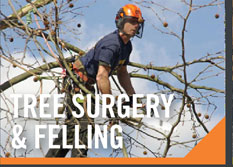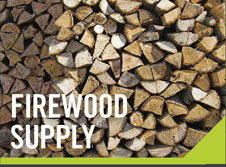Tree Surgery
We have years of experience in tree surgery dealing with all kinds of tree problems or maintenance issues. This section aims to give you a grasp of the terminology used by tree contractors so as to avoid misunderstandings and to make sure that you thoroughly understand exactly what tree work you sign off on the tree contractor's plans.
Formative pruning
To train your young trees into attractive healthy shapes they are likely to need annual attention - both to evaluate the growth of the tree and to carry out corrective pruning. While trees are young, though they need little pruning, their structural integrity can be determined for the life of the tree, in other words a little attention now will protect from wind, snow and storm damage later in life. If you would like to shape the crown of the adult tree, formative pruning should start in the nursery and certainly not beyond 5 years of planting. Your tree contractor knows how to prune effectively to avoid removing too much leaf cover at any one time, so damaging the tree.
Crown thinning
This is usually done for specific reasons such as to allow more light through a tree's canopy into your garden. It's not an ideal method to relieve overloaded branches, in fact it can actually worsen a weakened branch, so it should be done with care, evenly throughout the crown to avoid creating gaps. No more than 30% of the leaf bearing crown should be removed. Cutting branches back to the main stem should be particularly avoided by anyone other than a professional.
Crown Lifting
This clears the main stem of the tree of branches up to a certain level, and is most often used where a tree overhangs a road which needs a specific clearance (usually 5.5m) for vehicles to pass, for example. A qualified tree surgeon removes the branches and will not remove more than 15% of the live crown height.
To brief a crown lift, you must specify exactly what your measurements are for the clearance required, for example from the lowest branch to the ground level or from the lowest remaining foliage to ground level.
Crown lifting should be achieved over a number of years so as to allow the tree to recover from the 'wounds' over time. In older trees there is a probability of decay in the wound which can lead to dangerous branch failure in the tree. Your tree contractor will take into account the size of the target clearance, the size and growth potential of the tree and the tree's current branching patterns.
Crown Reduction
This is a general all-over reduction in the size of the crown of the tree, both height and spread. It's done to preserve the health and lifespan of older trees by reducing the stress on the tree caused by the weight of branches. As the main framework of the crown is retained, most of the foliage-bearing structure remains so as to keep the tree healthy and vital. When you specify your requirements to a tree contractor you will be asked to provide a percentage or fraction of the crown to be removed - 20% is usually the maximum that can be taken off without damaging the tree's growth.
Felling
Tree felling is a skilled and potentially dangerous operation that should be undertaken only by a competent team of tree contractors. Only in areas where there is no potential risk to people or property can a tree be felled in one piece, as often seen on screen. In areas where there are restrictions, e.g. proximity to buildings, fences, roads, other features, where land around the tree is in use, or where there are other trees or shrubs which are to be retained that are in the way, trees should be dismantled in sections. This is called Sectional Felling. A Work Zone - a safe working distance - should be maintained between the tree to be felled and any other activities happening in the area. Large branches should not be allowed to fall freely in these restricted zones - instead they might be supported and lowered carefully possibly by a rig or a crane where the situation demands it.
Crown Cleaning - the removal of dead branches and climbing plants
The most common requirement for employing a tree surgeon is for the removal of dead branches.
The shedding of branches is a natural process of the development and ageing of trees - dead branches can provide essential habitats for many species of plant or animal. However, dead branches should be removed if they pose a risk to people or property, for example if hanging over a highway or house. The risk is also determined according to the size and type of deadwood.
Removing climbing plants from a tree could be necessary for a number of reasons, for example; to avoid the tree crown being smothered, to remove a plant that is hiding a decaying tree trunk which could be dangerous, or to remove it from high in the crown where it might be increasing the tree's resistance to the wind, thereby placing stress on the tree itself.
A tree surgeon will remove these carefully if necessary taking care not to damage the tree and the wildlife that might use the plant as a home or feeding ground.
Hedge Cutting
Hedges of any size can be topped and trimmed to your specific dimensions.
If you'd prefer more in-depth advice on the procedure you require, see our Tree Surgery FAQs.
Alternatively contact Durham Arb today to arrange a free, no-obligation quote.







